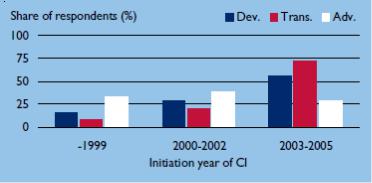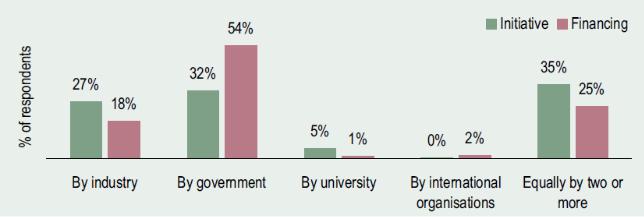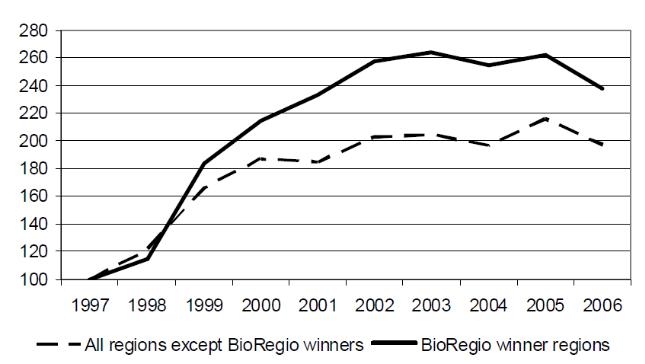
getpdf (1)
.pdf
Evgeniy Kutsenko, Dirk Meissner
KEY FEATURES OF THE FIRST PHASE OF THE NATIONAL CLUSTER PROGRAM
IN RUSSIA
BASIC RESEARCH PROGRAM
WORKING PAPERS
SERIES: SCIENCE, TECHNOLOGY AND INNOVATION
WP BRP 11/STI/2013
This Working Paper is an output of a research project implemented
at the National Research University Higher School of Economics (HSE). Any opinions or claims contained in this Working Paper do not necessarily reflect the views of HSE.

Evgeniy Kutsenko1, Dirk Meissner2
KEY FEATURES OF THE FIRST PHASE OF THE NATIONAL
CLUSTER PROGRAM IN RUSSIA
Cluster policy is recognized as one of the pivotal elements of state-of-art innovation policy. State support for clusters helps to take into account regional peculiarities and engage the most innovative local actors into the process of innovation policy drafting and implementation. Cluster development stimulates trust building and enhances knowledge spillovers among different organizations in the region. Finally the cluster approach makes innovation policy more systemic by coordinating measures aimed to support different actors (large companies, SMEs, universities, venture funds) towards comprehensive efforts linking the most perspective localized industries (ecosystems).
The development of clusters has been determined as one of the priorities of the Strategy of Innovative Development of the Russian Federation for the period to 2020 which was confirmed end 2010. In the framework of this Strategy the first national cluster program was launched in 2012.
The paper is devoted to the detailed description of the background of the national cluster program in Russia and its first phase – the selection of the pilot innovative clusters – which was implemented last year. Special attention is given to the comparison of planned design of the Russian cluster program with such widely known cluster programs as the BioRegio, InnoRegio and Les pôles de compétitivité. The similarities and peculiarities of the Russian program have been defined that allowed to identify several most significant areas for improvement.
Keywords: Clusters, knowledge spillovers, cluster policy, innovation policy. JEL classification: O14, O17, O25, O38, O 43, P16, R11, R 53.
1Senior Research Fellow, Centre for S&T, Innovation and Information Policies, Institute for Statistical Studies and Economics of Knowledge, National Research University – Higher School of Economics (HSE), ekutsenko@hse.ru
2PhD, Deputy Head, Laboratory for Science and Technology Studies, Institute for Statistical Studies and Economics of Knowledge, National Research University Higher School of Economics, dmeissner@hse.ru
Introduction
Achieving sustainable competitiveness of the Russian economy and enhancing quality of life is a challenge which requires solutions for one of the most difficult social and economic problems - the comprehensive modernization and growth of innovation activities of economic entities. International experience shows that in recent years innovation policy has taken special account of the innovation profiles’ peculiarities in the different parts of the state (regions) and the active involvement of these regions in the drafting and implementation of innovation policy [Foray et al.., 2009; Camagni, Capello, 2012]. In this context, clusters are playing a more and more significant role as they are considered to produce knowledge spillovers which occur in different forms and intensity between cluster participants and also beyond the actual cluster.
Russia launched the nationwide cluster program in 2012. The selection of the pilot innovative clusters was the first phase of this program which is being continued in 2013, once the Russian government has defined the main tools for the future support of pilot innovative clusters.
In this paper we take a closer look at the first phase of the Russian cluster program’ implementation. First of all, we explore the question of the extent to which this program complies with international best practice and to the extent it is determined by a number of limitations inherent in the Russian economy.
The first chapter gives an introduction on spillovers from clusters and the global emergence of cluster initiatives and cluster policies. The second chapter describes the context in which Russian cluster policy was defined, followed by the third chapter on the criteria and procedures for the selection of pilot innovative clusters and the proposed mechanism of federal support. Finally, the fourth chapter identifies ways of improving cluster policies in Russia on the basis of comparison with international experience.
1. Evolvement of cluster policies
1.1. Knowledge spillovers from and by clusters
Clusters are geographic concentrations of interconnected companies and institutions in a particular field [Porter, 2008, P.78]. Clusters are initiated and supported with the aim of generating 3

different positive externalities for its “residents” including reduced transportation and production costs, access to common infrastructure and labor market, etc.. Knowledge spillovers are among the pivotal positive externalities and nowadays are becoming one of most important motivations for the establishment of clusters. Knowledge spillovers per se are often spillovers of tacit knowledge, e.g. the exchange of personalized information (experience, latest news, etc.) between individuals which differs significantly from the exchange of codified knowledge. Such interaction typically requires confidence and trust between the individuals which is mainly built and generated through direct personal interactions (Zaytseva et. al 2013). Clusters at the same time aim strongly at the interaction of individuals hence the exchange of tacit knowledge. Thus clusters and networks are an important institution for the diffusion of tacit knowledge. However, clusters alone do not necessarily generate innovation in the broader sense but it seems likely that clusters grow around a knowledge base generating even more new knowledge which is not necessarily transformed into innovation at the same location. Spillovers within clusters can take a broad range of forms (table 1).
Table 1: spillovers from cluster
|
|
Horizontal |
Vertical |
|
Direction |
Exchange between people and institutions |
Exchange between different levels of the |
||
|
|
at same level |
value chain) |
|
|
|
|
|
|
Organization |
Intra-organizational |
Inter-organizational |
||
Within organization based in cluster |
Between organizations based in cluster |
|||
|
|
|||
|
|
|
|
|
Interaction |
Direct |
Indirect |
||
No third party involved |
Facilitator, cluster member involved |
|||
|
|
|||
|
|
|
|
|
|
|
Technology push |
Demand pull |
|
Process |
Spill-over existing knowledge |
Search for new solutions for given |
||
|
|
|
challenge |
|
|
|
|
|
|
|
|
Imitation |
Adaptation |
|
Adaptation |
|
|
|
|
|
Direct transfer without technical adoption |
Adapted solution according to users |
||
|
|
|
requirements |
|
Source: Meissner, D. (2012) |
|
|||
Spillovers occur in different directions - horizontal or vertical. Horizontal spillovers mean the exchange of objects between individuals or institutions at the same level. Vertical knowledge and technology spillovers take place mainly in various stages of the innovation process, i.e. between providers (scientists, universities, research institutes, etc.) and recipients (e.g. businesses, social institutions) of knowledge and technology. However, it is possible that individual stages of the innovation process can be skipped. This is particularly important for small and medium-sized enterprises (SMEs), in which R&D and innovation activities due to a lack of resources are limited.
4
Empiric surveys, namely by Czarnitzik and Kraft for the German manufacturing industry using data from ZEW Mannheimer Innovationspanel, confirm that vertical spillovers have a positive sustainable impact on companies’ performance while horizontal spillovers are less likely to do so [Czarnitzik and Kraft 2007]. To capture vertical knowledge, clusters normally include actors which play different roles in the innovation process: large companies, SMEs, universities and scientific organizations, governmental agencies and infrastructure organizations (technology parks, business incubators, technology transfer centers, industrial design centers. etc., Kotzemir, Meissner 2013).
Inter-organizational spillovers are the external sourcing and/or exploitation of knowledge and technology especially by companies. This is an essential part of technology and innovation management when converting inventions generated from an institution’s explorative and R&D activities into innovation within an organization whereas intra-organizational spillovers is mainly an issue of company innovation management. Also structured hierarchical levels of institutions engaged in spillovers play an important if not crucial role.
Spillovers happen directly or indirectly. Direct spillovers mean that know-how and/or technology from inventing entities are transferred to recipients on their initiative and do not require support of technology intermediaries. Indirect spillovers are the mediated transfer of opportunities involving one or more intermediaries. Clusters play an important role for indirect spillovers, e.g. spillovers from current R&D to future R&D activities. These spillovers can be traced back to the knowledge generation process, e.g. knowledge and competences resulting from R&D activities are commonly used for further application in the form of tacit or codified knowledge. In this way cluster based R&D activities generate spillovers which contribute substantially to generating new knowledge, which in turn eventually enhances local innovators absorptive capacity to take advantage of external technology and innovation. This affects R&D prospects of cluster based companies but also the future R&D of external companies. Consequently such spillovers are realized by external companies but also research institutes and education institutions which in the long term contribute to the attractiveness of clusters since cluster members and external actors realize the resulting effects. However this is a long term effect which so far can’t be measured reliably.
Technology-push spillovers mean the transfer of existing technical know-how and technologies to new fields and applications. Otherwise, possible solutions to a given problem, in form of new technologies, sought from other areas, constitute demand-driven spillovers.
5
The initiative of transfer is through a direct transfer, without any technical adaptation of the absorbing organization (imitation), i.e. the technology is used one to one. Hence it is merely a "relocation", while in case of adaptive spillovers, further activities are required to customize the application of new knowledge to the specific needs and circumstances of the recipient.
Among the many important factors for the development and growth of clusters, the personal direct interaction of individuals in a geographic proximity - despite the availability of modern information and communication technologies – is especially relevant. This is shown in various studies on different industry sectors:
Zucker et al and Feldman showed the impacts for biotechnology [Zucker et al 1998; Feldman 2000];
Pinch, Henry and Almeida, Kogut for motor sport and semiconductor industry [Pinch, Henry 1999; Almeida, Kogut 1999];
Fallick et.al. for Silicon Valley computer industry [Fallick et.al. 2004];
Niosi, Zhegu for aerospace industry [Niosi, Zhegu 2005].
The different spillover types caused and stimulated by clusters can have a varying impact on the cluster participants and the cluster as a whole (Table 2). It’s obvious that clusters mainly have a long term impact which is only measurable to some extent. The main reason being causality, e.g. the interaction of cluster participants isn’t quantifiable.
Table 2: Impact, measurability and time to take effect of spillovers in clusters
Spillover type |
|
Impact by cluster |
measurability |
Time for |
|
|
|
|
taking effect |
||
|
|
|
|
||
|
|
|
|
|
|
Direction |
Horizontal |
Medium |
Limited |
Long |
|
Vertical |
High |
Limited |
Medium |
||
|
|||||
|
|
|
|
|
|
Organization |
Intra-organizational |
Low |
Limited |
Short |
|
Inter-organizational |
High |
Measurable |
Long |
||
|
|||||
|
|
|
|
|
|
Interaction |
Direct |
Medium |
Measurable |
Medium |
|
Indirect |
High |
Limited |
Short |
||
|
|||||
|
|
|
|
|
|
Process |
Technology push |
High |
Measurable |
Medium |
|
Demand pull |
High |
Measurable |
Medium |
||
|
|||||
|
|
|
|
|
|
Adaptation |
Imitation |
Low |
Limited |
Short |
|
Adaptation |
High |
Limited |
Medium |
||
|
|||||
|
|
|
|
|
It should be noted here that clusters have impacts on participants but the time frame for such impacts to occur is long term rather than short term.
6

1.2 Evolution of cluster policies and initiatives
International studies indicate the relative "youth" of cluster initiatives; even in the most developed countries more than 60% of these projects were launched after 1999 and cluster initiatives in developing and transition countries are even younger (Figure 1). In the 2000s a period of rapid proliferation of cluster initiatives, organized either by business or academia or authorities of any kind, around the world began. Interestingly, while in 2003 more than 500 cluster initiatives around the world were identified, primarily in Europe, North America, New Zealand and Australia
[Sölvell et al., 2003], in 2005 there were already around 1400 [Ketels et al., 2006].
Figure 1. The initiation year of cluster initiatives in developed, developing and transition countries (%)
Source: Ketels C., Lindqvist G., Sölvell Ö. (2006) Cluster Initiatives in Developing and Transition Economies.
Stockholm: Center for Strategy and Competitiveness. P.13.
A survey of cluster initiatives showed that in the first stage of their development, government support, not only organizational and consulting support, but also financial, is very important. Interviewing more than two hundred members of cluster initiatives around the world, the authors of the Cluster Initiatives GreenBook, came to the conclusion that most of them are financed through public funds, though the organizational role is weaker (Figure 2).
7

Figure 2. Initiating and financing cluster initiatives
Source: Sölvell Ö., Lindqvist G., Ketels C. (2003) The Cluster Initiative Greenbook. Stockholm: Bromma Tryck
AB, P.39.
In the 1970's and 80's, prior the emergence of large-scale cluster programs at national level, local programs which share similar general principles and values have been launched in some regions. These are especially:
Emilia-Romagna and Veneto (Italy),
Baden-Württemberg and North Rhine-Westphalia (Germany) and
Styria and Upper Austria (Austria).
Since the second half of the 1990s some countries have gradually begun to form national cluster programs. By the end of the 2000s national cluster programs were implemented in 26 member countries of the European Union [Oxford Research, 2008]. Currently targeted support to clusters under the umbrella of state cluster policy is given in Australia, Austria, Belgium, Britain, Denmark, Germany, India, Spain, Italy, Canada, Norway, Poland, the Republic of Korea, Singapore, Slovenia, Spain, Sweden , Japan and other countries [OECD, 2007; Pro Inno Europe, 2012].
Despite government intervention in the process of clusters evolution has been subjected to criticism [Duranton, 2011; Desroches, 2011; Martin, Mayer, Mayneris, 2008; Martin, Mayer, Mayneris, 2010], some practices of implementation of cluster policies in leading countries show the effectiveness of the this policy. In particular, the outcome of the program BioRegio, in course of which the number of companies was quadrupled and more than nine thousand jobs in the biotechnology sector were created and which will significantly reduce the gap with the traditional leaders, e.g. Great Britain, is convincing. Within BioRegio participating regions achieved more notable success compared to other federal states (Figure 3). Today, Germany is seen as the European leader in the field of biotechnology, hosting 552 biotech companies. Their overall turnover reached
8

2.6 billion euros in 2011 (a growth rate of 30% for the period 2005-2008), employing 16.300 people
[Biotechnologie.de, 2012].
Figure 3. Increase in the number of DBFs in the BioRegio winner regions and in the rest of Germany (1997=100)
Source: Dohse D., Staehler T. (2008) BioRegio, BioProfile and the Rise of the German Biotech Industry //
Working paper № 1456. Kiel, Germany. P.7. http://www.ifw-members.ifw-kiel.de/publications/bioregio- bioprofile-and-the-growth-of-the-german-biotech-industry/KWP_1456.pdf (accessed 16 August 2012).
The implementation of another well-known German cluster program - InnoRegio - during 2000-2004 has led to an increase in employment by 11% by companies included in the program. Moreover, 44% of these companies filed patents and 40% launched new products [BMBF, 2006].
The success of these and other programs inspired many regions and countries, including Russia, to design and implement their own cluster programs.
9
2. Background of cluster policy in Russia
The majority of the problems that hinder the innovative development of Russia fall into one of two basic categories.
The first is the low innovation activity of businesses that generate insufficient demand for innovation. The level of innovation activities of Russian companies has been around 10% since the early 2000s, giving an advantage not only to leading industrialized countries, but also to Eastern European countries. Innovation activity of enterprises is based mainly on the acquisition of machinery and equipment, rather than on R&D aimed at radical novelties [Gokhberg, Kuznetsova, 2011]. The level of intensity of both technological and non-technological (organizational, marketing) innovations is twice as low. Russia is also characterized by a low share of innovation expenditure as a percentage of sales: 1.5% whereas in Sweden the average for the whole economy was 5.4% and in Germany 3.4%. Moreover, growing innovation expenditure is not necessarily accompanied by increasing turnover with innovative products as a share of total sales. The latter was approximately 5% between 1995 - 2010 [Strategy - 2020, 2012].
The second problem is the low efficiency of the domestic R&D sector, especially its isolation from the needs of the business community. Traditionally scientific organizations in Russia are independent from universities and enterprises, most of them being incorporated in the Russian Academy of Science. Scientific organizations account for 80% of total expenditure on science, although the backbone of innovation systems in developed market economies are universities and corporations. The R&D sector is dominated by government budget-funded institutions and other forms of organizations with substantial participation of the state. The applied sciences sector is dominated by sectoral (departmental) R&D institutes rather than industrial enterprises, whose share does not exceed 7% of all organizations engaged in R&D. Only 45% of higher education institutions are engaged in R&D, and they accommodate just 7% of the national R&D expenditure total (2.5 times lower than the OECD average) (figure 4) [Strategy - 2020, 2012; Gokhberg, Kuznetsova, 2011].
10
